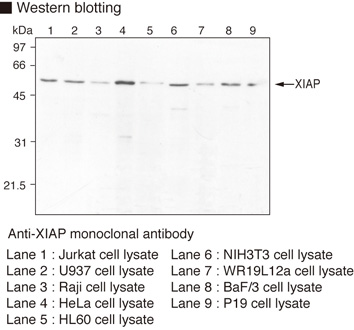- Japan(Japanese / English)
- Global
- MBL TOP
- MBL site search
Close
This site is for customers in Japan.
Customers in other regions, please go to Global page.
HOME >
Product search results > Code No. M044-3
Anti-XIAP (MIHA/ILP-a) mAb
Price
¥52,800
Availability (in Japan)
10 or more
(In Japan at 00:05,
Apr 20, 2024 in JST)
Size
100 µL (1 mg/mL)
This antibody recognizes C-terminal region of XIAP (352-449 aa) and detects 55 kDa of XIAP on Western Blot using total cell lysate from human or mouse cell line, for example, Jurkat, Raji, NIH/3T3, etc.
| Data | |||||
|---|---|---|---|---|---|
| Clonality | Monoclonal | Clone | 2F1 | ||
| Isotype (Immunized Animal) | Mouse IgG1 | ||||
| Applications | |||||
| Immunogen (Antigen) | Recombinant Human full length XIAP | ||||
| Reactivity [Gene ID] | |||||
| Storage buffer | 1 mg/mL in PBS/50% glycerol, pH 7.2 | ||||
| Storage temp. | -20°C | Conjugate | Unlabeled | Manufacturer | MBL |
| Alternative names | X-linked inhibitor of apoptosis, API3, ILP1, XLP2, BIRC4, IAP-3, hIAP3, hIAP-3 | ||||
| Background | Caspase, related to ICE and to CED-3, plays central roles as effectors of apoptosis. Ablation of caspase activity is attained by p35 from baculovirus and CrmA from cowpox, which appear to be suicide inactivators, strongly inhibiting caspase activity. Overexpression of there caspase inhibitors in insect, nematoda and mammalian cells results in resistance to apoptotic stimuli, demonstrating that components of the apoptotic pathway are highly conserved throughout evolution, and leading to the speculation that mammalian functional equivalents of these protease inhibitors may exist. The inhibitor of apoptosis proteins (IAPs) are a family of anti-apoptotic proteins that are conserved across species. Four IAPs have been identified in mammal; NAIP, cIAP1/HIAP2/hMIHB, cIAP2/HIAP1/hMIHC, XIAP/hILP. A prototype of the human IAPs is the XIAP, with a 1.5 kb coding region corresponding to a 55 kDa protein. XIAP can directly inhibit two members of the cell death protease family, caspase-3 and -7. | ||||
| Related products | M097-3 Anti-Caspase-3 (Human) mAb M087-3 Anti-Caspase-3 (Human) mAb M053-3 Anti-Caspase-7 mAb M054-3 Anti-Caspase-9 mAb |
||||
| Citations |
Western Blotting
Immunohistochemistry
|
||||
| Product category |
|
||||
- The availability is based on the information in Japan at 00:05, Apr 20, 2024 in JST.
- The special price is shown in red color.
- Please note that products cannot be ordered from this website. To purchase the items listed in this website, please contact us or local distributers.
- Abbreviations for applications:
WB: Western Blotting, IH: Immunohistochemistry, IC: Immunocytochemistry, IP: Immunoprecipitation
FCM: Flow Cytometry, NT: Neutralization, IF: Immunofluorescence, RIP: RNP Immunoprecipitation
ChIP: Chromatin Immunoprecipitation, CoIP: Co-Immunoprecipitation
DB: Dot Blotting, NB: Northern Blotting, RNA FISH: RNA Fluorescence in situ hybridization - For applications and reactivity:
*: The use is reported in a research article (Not tested by MBL). Please check the data sheet for detailed information.
**: The use is reported from the licenser (Under evaluation or not tested by MBL).
- For storage temparature: RT: room temparature
- Please note that products in this website might be changed or discontinued without notification in advance for quality improvement.









 Citations
Citations Data Sheet
Data Sheet


